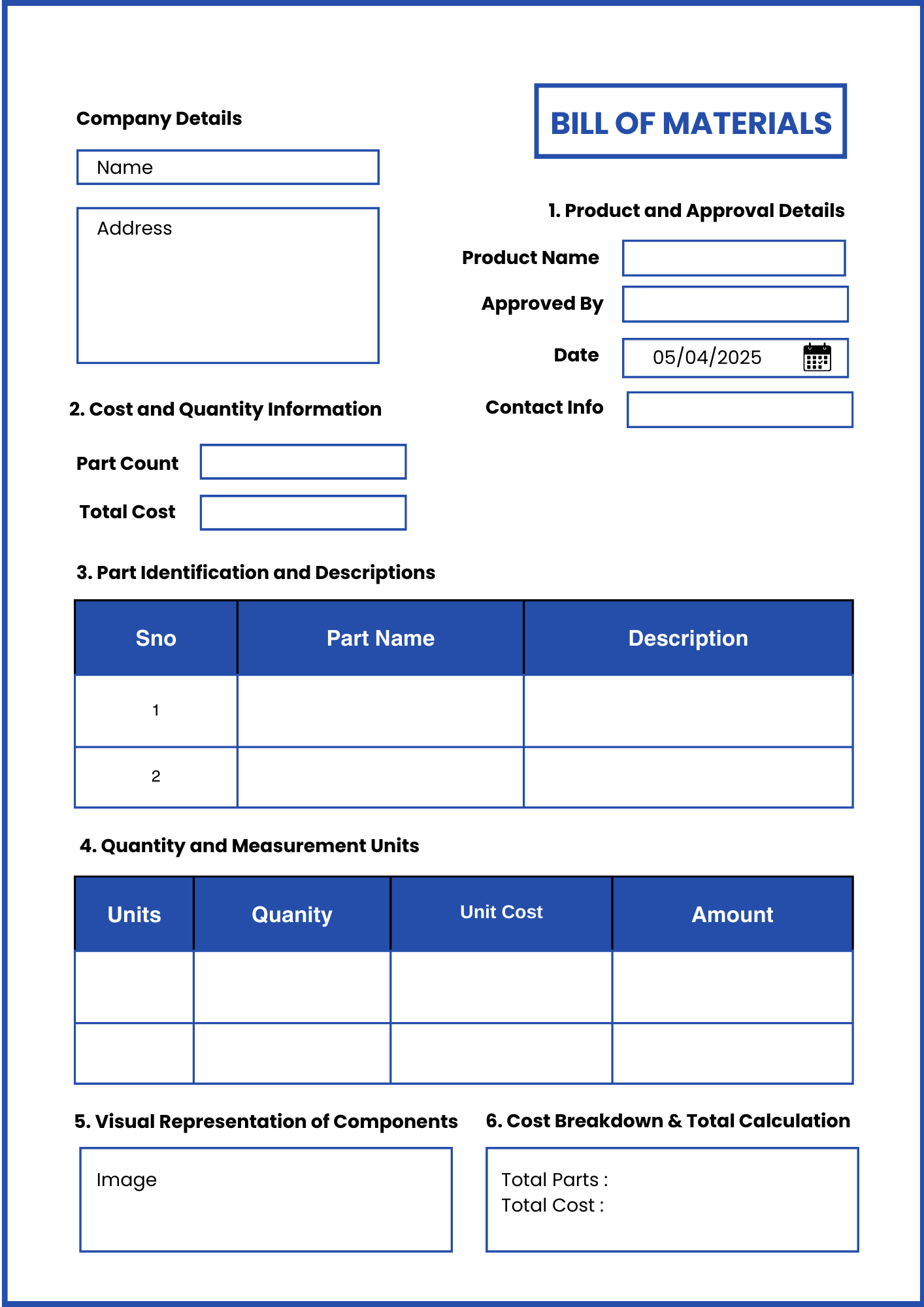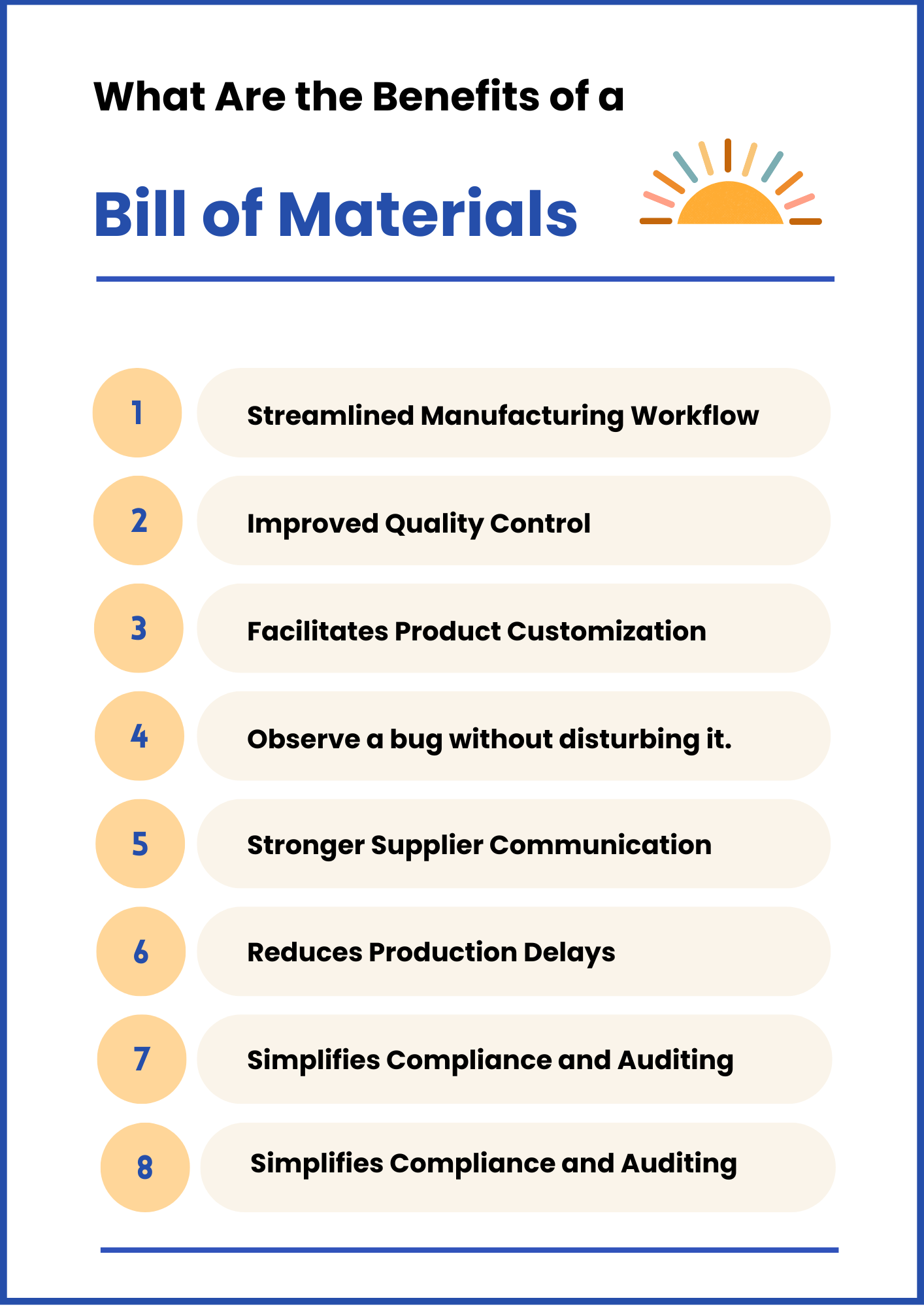Free Bill of Materials Generator
Generate a free bill of materials effortlessly! Simply fill out the template below, then download or print your bill of materials for free.
What Should be Included in a Bill of Materials
A Bill of Materials (BOM) is a crucial document in manufacturing, detailing the components required for product assembly. Based on the provided image, here are the key elements to include:
1. Product and Approval Details
- Product Name: The specific name or model of the product being assembled.
- Approved By: The person or department responsible for approving the BOM.
- Date of Approval: The date when the BOM was finalized for production.
- Contact Info: Essential for communication regarding product details and approvals.
2. Cost and Quantity Information
- Part Count: The total number of unique components used in the assembly.
- Total Cost: The sum of all component costs, providing a budget estimate for production.
3. Part Identification and Descriptions
- Part Number: A unique identifier for each component for easy tracking.
- Part Name: The specific name of the part used in the product.
- Description: A brief explanation of the component’s purpose or specifications.
4. Quantity and Measurement Units
- Quantity: The required number of each part for product assembly.
- Units: Measurement units (e.g., pieces, meters, kilograms) for accurate procurement and usage.
5. Visual Representation of Components
- Part Image: A graphical or schematic representation to help in identification and assembly.
6. Cost Breakdown and Total Calculation
- Unit Cost: The price of each individual component.
- Amount: The total cost of each component (calculated as quantity × unit cost).
- Total Parts and Total Cost: Summarized figures ensuring all necessary materials and expenses are accounted for.
What Are the Benefits of a Bill of Materials?
A well-organized BOM improves productivity, reduces costs, and ensures product consistency, making it an essential tool in manufacturing. Key benefits include:
✔ Streamlined Manufacturing Workflow: Ensures all materials, processes, and assembly steps are documented, reducing downtime and increasing efficiency.
✔ Improved Quality Control: Provides a reference for quality checks, ensuring all components meet required standards before final assembly.
✔ Facilitates Product Customization: Helps businesses modify products easily by adjusting component lists for different versions or upgrades.
✔ Stronger Supplier Communication: Enables seamless collaboration with vendors by providing precise specifications for sourcing materials.
✔ Reduces Production Delays: By pre-planning materials and quantities, a BOM ensures timely availability, avoiding project slowdowns.
✔ Simplifies Compliance and Auditing: Maintains detailed records that assist in regulatory compliance and quality certifications.
✔ Optimizes Lifecycle Management: Helps in product updates, repairs, and replacements by tracking parts across various product versions.
What Are the Advantages of Using a Bill of Materials?
A Bill of Materials (BOM) streamlines manufacturing processes by providing accurate part details, reducing errors, and improving efficiency. The key advantages include:
🔹 Enhanced Production Planning: A BOM helps in forecasting material needs, ensuring all components are available for uninterrupted manufacturing.
🔹 Improved Inventory Management: It tracks component usage, prevents overstocking or shortages, and optimizes warehouse space for better efficiency.
🔹 Cost Control and Budgeting: By listing material costs, a BOM helps businesses estimate expenses and prevent budget overruns during production.
🔹 Minimized Errors and Rework: Standardized documentation reduces miscommunication, ensuring the right parts are used, avoiding costly mistakes.
🔹 Faster Procurement Process: A well-defined BOM simplifies purchasing by providing vendors with precise details for timely material acquisition.
🔹 Efficient Product Assembly: With structured component listings, production teams can follow precise guidelines, speeding up the assembly process.
Bill of Materials FAQs
What Is Required to Create a Bill of Materials?
Creating a Bill of Materials requires product details, part numbers, descriptions, quantities, unit costs, supplier information, assembly instructions, and approval records. A well-structured BOM ensures accurate manufacturing, procurement, and inventory management.
What Is Single-Level Bill of Materials?
A Single-Level Bill of Materials lists all components required for product assembly without subassemblies or hierarchical relationships. It is ideal for simple products but lacks the complexity needed for multi-stage manufacturing.
Why Should You Use a Bill of Materials?
A Bill of Materials improves manufacturing efficiency, cost estimation, inventory tracking, and error reduction while ensuring seamless communication between procurement, production, and suppliers. It enhances quality control and optimizes supply chain management.
Who Can Benefit With Bill of Materials?
Manufacturers, suppliers, engineers, designers, and procurement teams benefit from a Bill of Materials by ensuring efficient production, accurate material sourcing, cost control, inventory management, and structured assembly processes for quality-driven manufacturing.
What Is Bill of Materials Structure?
A Bill of Materials structure includes hierarchical or flat listings of raw materials, components, subassemblies, descriptions, quantities, unit costs, and supplier details, ensuring smooth manufacturing, procurement, and inventory planning.


